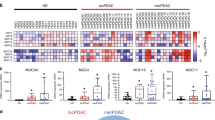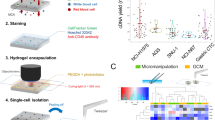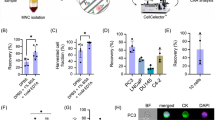Abstract
Circulating tumour cells (CTCs) shed into blood from primary cancers include putative precursors that initiate distal metastases1. Although these cells are extraordinarily rare, they may identify cellular pathways contributing to the blood-borne dissemination of cancer. Here, we adapted a microfluidic device2 for efficient capture of CTCs from an endogenous mouse pancreatic cancer model3 and subjected CTCs to single-molecule RNA sequencing4, identifying Wnt2 as a candidate gene enriched in CTCs. Expression of WNT2 in pancreatic cancer cells suppresses anoikis, enhances anchorage-independent sphere formation, and increases metastatic propensity in vivo. This effect is correlated with fibronectin upregulation and suppressed by inhibition of MAP3K7 (also known as TAK1) kinase. In humans, formation of non-adherent tumour spheres by pancreatic cancer cells is associated with upregulation of multiple WNT genes, and pancreatic CTCs revealed enrichment for WNT signalling in 5 out of 11 cases. Thus, molecular analysis of CTCs may identify candidate therapeutic targets to prevent the distal spread of cancer.
This is a preview of subscription content, access via your institution
Access options
Subscribe to this journal
Receive 51 print issues and online access
$199.00 per year
only $3.90 per issue
Buy this article
- Purchase on SpringerLink
- Instant access to full article PDF
Prices may be subject to local taxes which are calculated during checkout




Similar content being viewed by others

Change history
24 October 2012
Nature 487, 510–513 (2012); doi:10.1038/nature11217 In this Letter, we omitted the following accession information. The digital gene expression matrix and the Helicos single-molecule sequence data from which it was derived are available at the NCBI GEO database with accession number GSE40176. A total of 44 samples were uploaded including 12 mouse and 32 human samples.
References
Yu, M., Stott, S., Toner, M., Maheswaran, S. & Haber, D. A. Circulating tumor cells: approaches to isolation and characterization. J. Cell Biol. 192, 373–382 (2011)
Stott, S. L. et al. Isolation of circulating tumor cells using a microvortex-generating herringbone-chip. Proc. Natl Acad. Sci. USA 107, 18392–18397 (2010)
Bardeesy, N. et al. Both p16Ink4a and the p19Arf-p53 pathway constrain progression of pancreatic adenocarcinoma in the mouse. Proc. Natl Acad. Sci. USA 103, 5947–5952 (2006)
Ozsolak, F. et al. Amplification-free digital gene expression profiling from minute cell quantities. Nature Methods 7, 619–621 (2010)
Wang, L., Feng, Z., Wang, X. & Zhang, X. DEGseq: an R package for identifying differentially expressed genes from RNA-seq data. Bioinformatics 26, 136–138 (2010)
Ting, D. T. et al. Aberrant overexpression of satellite repeats in pancreatic and other epithelial cancers. Science 331, 593–596 (2011)
Reynolds, B. A. & Weiss, S. Clonal and population analyses demonstrate that an EGF-responsive mammalian embryonic CNS precursor is a stem cell. Dev. Biol. 175, 1–13 (1996)
Dontu, G. et al. In vitro propagation and transcriptional profiling of human mammary stem/progenitor cells. Genes Dev. 17, 1253–1270 (2003)
Katoh, M. WNT signaling pathway and stem cell signaling network. Clin. Cancer Res. 13, 4042–4045 (2007)
Hoshida, Y. et al. Integrative transcriptome analysis reveals common molecular subclasses of human hepatocellular carcinoma. Cancer Res. 69, 7385–7392 (2009)
Ninomiya-Tsuji, J. et al. A resorcylic acid lactone, 5Z–7-oxozeaenol, prevents inflammation by inhibiting the catalytic activity of TAK1 MAPK kinase kinase. J. Biol. Chem. 278, 18485–18490 (2003)
Bowers, J. et al. Virtual terminator nucleotides for next-generation DNA sequencing. Nature Methods 6, 593–595 (2009)
Ozsolak, F. et al. Digital transcriptome profiling from attomole-level RNA samples. Genome Res. 20, 519–525 (2010)
Lipson, D. et al. Quantification of the yeast transcriptome by single-molecule sequencing. Nature Biotechnol. 27, 652–658 (2009)
Acknowledgements
We thank C. Koris and the MGH clinical research coordinators for help with clinical studies, J. Gentry for computer informatics support, L. Libby for mouse studies, J. Walsh for microscopy expertise, Z. Nakamura for technical support, D. Jones for sequencing, and M. Rivera and S. Akhavanfard for RNA-ISH. This work was supported by Stand Up To Cancer (D.A.H., M.T., S.M.), Howard Hughes Medical Institute (D.A.H.), NIBIB Quantum Grant 5R01EB008047 (M.T.), NIH CA129933 (D.A.H.), Pancreatic Cancer Action Network – AACR Fellowship (D.T.T.), the Warshaw Institute for Pancreatic Cancer Research (D.T.T.), and the K12 Paul Calabresi Award for Clinical Oncology Clinical Research Career Development Program NIH 5K12CA87723-09 (D.T.T.).
Author information
Authors and Affiliations
Contributions
M.Y., D.T.T., S.M. and D.A.H. designed and conducted the study, analysed data, and prepared the manuscript. S.L.S. and M.T. contributed to the microfluidic system. D.T.T., B.S.W., F.O., B.W.B. and P.M.M. performed Helicos digital gene expression analysis. B.S.W. and S.R. performed bioinformatic and statistical analysis. S.P., J.C.C., M.E.S., D.W., A.J.G., M.J.U. and K.X. provided technical assistance for microfluidic experiments. M.Y., D.T.T., B.W.B. and J.C.C. performed RNA-ISH analysis. D.T.T., D.P.R. and L.V.S. acquired clinical samples. G.C., B.A. and N.B. provided the mouse model and cell line. S.L.S., B.S.W., P.M.M., S.R. and M.T. commented on the manuscript.
Corresponding authors
Ethics declarations
Competing interests
The authors declare no competing financial interests.
Supplementary information
Supplementary Information
This file contains Supplementary Figures 1-17 and Supplementary Tables 1-12. (PDF 13562 kb)
Rights and permissions
About this article
Cite this article
Yu, M., Ting, D., Stott, S. et al. RNA sequencing of pancreatic circulating tumour cells implicates WNT signalling in metastasis. Nature 487, 510–513 (2012). https://doi.org/10.1038/nature11217
Received:
Accepted:
Published:
Issue Date:
DOI: https://doi.org/10.1038/nature11217


